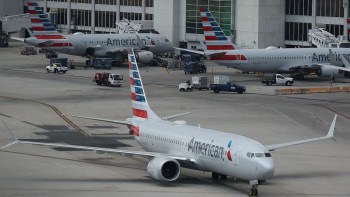
Air travel is almost completely grounded due to COVID-19, as these 6 charts show
Share Now on:
Air travel is almost completely grounded due to COVID-19, as these 6 charts show

The devastation that COVID-19 has caused on countless industries is still becoming clear. The travel businesses is one of the hardest hit. An estimated 95% of the population has been told to stay at home, and avoid unnecessary trips. That means almost nobody is flying.
United’s CEO told employees that he expects fewer people to to fly in the entire month of May 2020, than on a single day in May 2019. “Travel demand is essentially zero,” a statement from the company says.
APM’s Research Lab analyzed data published by the Transportation Security Administration on the number of people traveling in March and April 2019 vs 2020, to illustrate the dramatic decline.
In 2019, the TSA screened around 2.5 million passengers every day across the US, with some variation according to the day of the week. In April 2020, that has fallen to around 90,000 passengers. “I would say that we’re in free fall, except that we’ve already fallen,” says Samuel Engel, who leads the aviation group at consultancy ICF.
“To see a day when there are fewer than 2,500 passengers going through LaGuardia Airport in New York is a scene from a ghost town,” he said.
On March 19th, the US State Department raised its global travel advisory to Level 4 (you can find the latest updates here) effectively banning all international travel. Travel at all three of New York’s major airports was already on a downward trend in March, but after that date, the drop is steeper.
In Atlanta, and Los Angeles, the picture follows the national trend.
In cities and metro airports with several airports, airlines have made efforts to consolidate service. Instead of maintaining service to several airports, they are likely to now only serve one, and with far fewer flights per day. The effects of that can be seen in the data for the Washington, D.C. area.
Dulles is a hub for United, so that airline is still operating a number of flights in and out of Dulles, which helps explain why it’s now the busiest in the D.C. Metro area.
A condition of receiving government support is that airlines have to maintain a baseline level of service, for essential workers, political representatives, and other people who absolutely have to travel, even if that means flying empty planes. “The airline industry is not functioning as a consumer industry right now, it’s providing a public service that the government is subsidizing,” Engel said.
A graphic demonstration of the level of disruption to air travel can be seen in data from Denver International Airport. A storm in March 2019 caused the airport to close its runways for only the 4th time in history, and led to 1,400 flight cancellations. But more people were processed through TSA checkpoints then, compared to now. “That is incredible,” Engel said. When a whiteout blizzard made it impossible to travel, 20,000 people still tried to fly. Now fewer than 5,000 are passing through the airport. “That just demonstrates how the spigot has been turned off.”
There’s a lot happening in the world. Through it all, Marketplace is here for you.
You rely on Marketplace to break down the world’s events and tell you how it affects you in a fact-based, approachable way. We rely on your financial support to keep making that possible.
Your donation today powers the independent journalism that you rely on. For just $5/month, you can help sustain Marketplace so we can keep reporting on the things that matter to you.


















